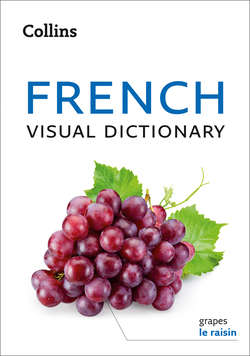Читать книгу Collins French Visual Dictionary - Collins Dictionaries - Страница 5
INTRODUCTION
ОглавлениеWhether you’re on holiday or staying in a French-speaking country for a slightly longer period of time, your Collins Visual Dictionary is designed to help you find exactly what you need, when you need it. With over a thousand clear and helpful images, you can quickly locate the vocabulary you are looking for.
The Visual Dictionary includes:
10 chapters arranged thematically, so that you can easily find what you need to suit the situation
images – illustrating essential items
YOU MIGHT SAY... – common phrases that you might want to use
YOU MIGHT HEAR... – common phrases that you might come across
VOCABULARY – common words that you might need
YOU SHOULD KNOW... – tips about local customs or etiquette
USING YOUR COLLINS VISUAL DICTIONARY
In order to make sure that the phrases and vocabulary in the Collins Visual Dictionary are presented in a way that’s clear and easy to understand, we have followed certain policies when translating:
1) The polite form “vous” (you) has been used throughout the text as this is always safe to use, even if a bit formal at times, for example:
How are you? Comment allez-vous?
Remember that if you are addressing an older person or someone you have just met, you use “vous”. However, if you are speaking to children, or those you know well, you can use “tu”. French people may invite you to use “tu” with them:
Shall we call each other “tu”? On se tutoie?
2) The grammatical gender of French nouns has been indicated using the articles “le” (masculine) or “la” (feminine). All nouns which have the article “l’” have been shown with their gender, for example:
year l’année f
All plural translations have been marked with the gender of the singular noun, as well as the plural marker, for example:
trainers les baskets fpl
Feminine forms of nouns have been shown with the masculine form as the main translation:
salesperson le vendeur / la vendeuse
3) In general, the masculine form of adjectives only has been shown for vocabulary items and in phrases, for example:
annoyed mécontent
I’m tired. Je suis fatigué.
However, in some cases both forms are shown:
I’m married/divorced. (man) Je suis marié / divorcé.
I’m married/divorced. (woman) Je suis mariée / divorcée.
Remember that, in French, the adjective often changes depending on whether the noun it describes is masculine or feminine. Often the adjective only adds an “e” to the end, so “content” becomes “contente” and “fatigué” becomes “fatiguée”. However, there are some adjectives that take different endings in the feminine form, or don’t change at all.
The adjective form also changes if you are talking about a person or object in the singular or in the plural. Usually, the plural form of the adjective is formed by adding “-s” (for masculine nouns) or “-es” (for feminine nouns) to the end of the word.
The girls are tired. Les filles sont fatiguées.
FREE AUDIO
We have created a free audio resource to help you learn and practise the French words for all of the images shown in this dictionary. The French words in each chapter are spoken by native speakers, giving you the opportunity to listen to each word twice and repeat it yourself. Download the audio from the website below to learn all of the vocabulary you need for communicating in French.
www.collinsdictionary.com/resources
